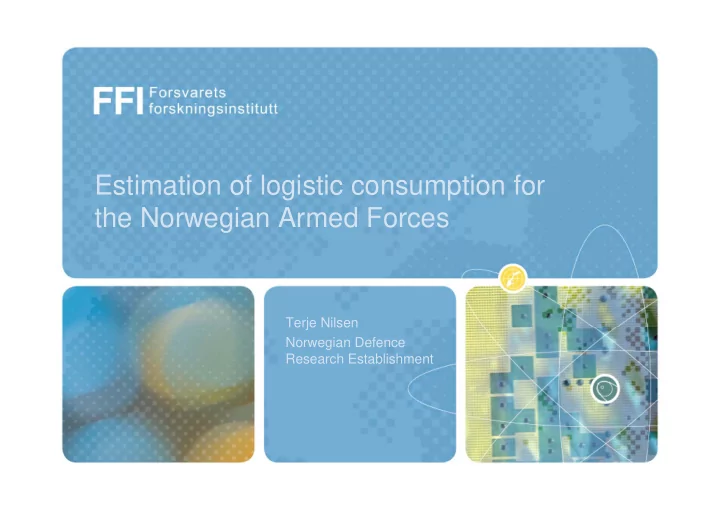

Estimation of logistic consumption for the Norwegian Armed Forces Terje Nilsen Norwegian Defence Research Establishment
”Be nice to a logistican if you want to Overview hear a BANG! and not a CLICK! .............” • Introduction • Consumption estimates – method – inputs – results • Consumption rates and prognosis • Methodological challenges • Conclusions
Introduction • NDRE has for about 6 years run a series of projects focussing on logistic issues • The main reason for calculating the consumption estimates is to support a long term planning study on operational logistics • Other applications of our estimation efforts are: – Logistics planning of stocks – Operational planning – Prognosis
Consumption estimates - method Existing expertise Scenario Units and estimates Personnel Gamepieces Activities Material (Units) Consumption rates Activity profile Casualty rates Consumption Special analysis Logistical requirements
Consumption estimates - inputs • The choice of units, scenario, activities, and activity profiles were all done in close cooperation with military expertise – The scenario was based on three criteria: 1) Relevance, 2) Scope, and 3) Representativity – Defined the activities after mapping all the different tasks the units were to do in the different missions – Activity profiles constructed by a sequence of activities for each unit • Consumption rates gathered from NDLO, staff handbooks, maintenance databases etc. • Casualty rates equal to zero
Consumption estimates - results • The results were made for the supply types: provisions, water, fuel, spare parts, and ammunition for each of the primary missions: training, defensive combat, offensive combat, normal and high stabilization • Calculated consumption estimates: – in weight, volume and cost for a standard seven days period of each of the primary missions – for an operation of six months duration based on a sequence of consumption of standard seven days period
Consumption rates and prognosis (1) • Focus on the resources in the ”big picture” • Focus on the resources in the ”big picture” Asset manager Asset manager • Able to overrule the self-organizing groups if • Able to overrule the self-organizing groups if needed needed Sensors Sensors Prognosis Prognosis Battle area Battle area Base Base Unit A Unit A TAV TAV • Self-organized • Self-organized Contractor Contractor Unit B Unit B Prognosis Prognosis Sensors Sensors Supply network Supply network Information network Information network Based on the ”Sense and Respond Logistics” concept (US)
Consumption rates and prognosis (2) • One objective in the ”Sense and Respond Logistics” concept is to decrease stocks (reduced ”footprint”) – one way to do this is to have accurate prognoses tools, and hence the best possible input numbers in the form of consumption rates • Our work gave consumption rates for the supply types: Water, provisions, fuel, spare parts, and ammunition – the consumption rates for all supply types except for spare parts is in the right measure to be used in prognoses tools • studies have been undertaken to get the right measure for spare parts but more work is necessary
Methodological challenges (1) ? • Verification of the level of accuracy – the results have only been validated intuitively by military experts – further validation: to compare the results with an actual operation as similar as possible to the scenario studied • Representativity of results Consumption estimates S1 Consumption estimates S14 Consumption estimates S2 – the most generic available scenario was used . . – necessary to get support from military expertise if the results . . . are going to be extrapolate to other scenarios . . .
Methodological challenges (2) • Area of application – four areas of application: Force structure planning, logistics planning of stocks, operational planning, and prognosis – operational planning: important for the operational planner to know all the assumptions that were used to get the results
Methodological challenges (3) • Deaggregation of results – the results for the supply types: water, provisions, fuel and ammunition all have the ”right” measure from a supplier point of view – the challenge consists of getting the results for spare parts from Norwegian kroner per hour (for each consumer) to number of per hour (for each spare part) – a solution could be to get a fixed distribution of spare parts being used by each consumer corresponding to a certain amount measured in Norwegian kroner
Conclusions • We now have: – a method for calculating consumption estimates – a set of calculated basic seven days operations that can be used for quick estimates of different operations • We would like to compare our results with experienced consumptions in real operations • The consumption rates for the supply types: water, provisions, fuel, spare parts, and ammunition, except spare parts, will constitute a good basis as input numbers to prognoses tools
Contact information: Terje Nilsen Division of analysis Norwegian Defence Research Establishment Terje.Nilsen@ffi.no + 47 63 80 77 85 + 47 41 62 16 56
Recommend
More recommend